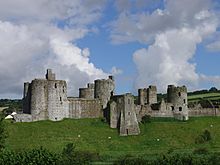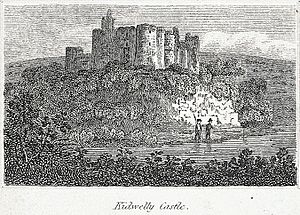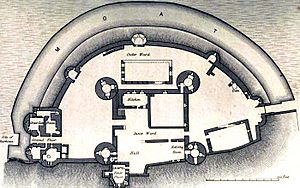Kidwelly Castle facts for kids
Quick facts for kids Kidwelly Castle |
|
|---|---|
| Carmarthenshire, Wales | |

Kidwelly Castle
|
|
| Coordinates | 51°44′22″N 4°18′21″W / 51.7394081°N 4.305735°W |
| Site information | |
| Owner | Cadw |
| Open to the public |
Yes |
| Condition | Ruined |
| Site history | |
| Battles/wars | Revolt of Owain Glyndŵr |
|
Listed Building – Grade I
|
|
Kidwelly Castle (called Castell Cydweli in Welsh) is an amazing castle from the Norman times. It stands tall over the River Gwendraeth and the town of Kidwelly in Carmarthenshire, Wales. The name Kidwelly might come from an old word, Cygweli, which means "swan."
Contents
Discover Kidwelly Castle's Story
This castle was built a very long time ago, starting in the early 1100s. The Normans built it to protect their land from the Welsh people. But the Welsh managed to capture the castle many times during the 12th century!
Battles and Sieges at Kidwelly
One famous event happened in 1403. A Welsh leader named Owain Glyndŵr tried to take the castle. He had help from soldiers from France and Brittany. They captured the town of Kidwelly, but they couldn't take the castle itself. A Norman army arrived in September 1403 and saved the castle.
Exploring the Castle's Design
Kidwelly Castle has a very strong and clever design. It has a square inner area called a bailey. This inner part is protected by four round towers. Around this, there's a semi-circular outer wall, called a curtain wall, on the side facing the land.
The main entrance, called the gatehouse, is huge and sits near the river. The river helps protect one side of the castle. Even though it's not a perfect concentric castle (which means having walls within walls all around), it's still very well protected. A special tower sticks out to guard the riverside walls.
Today, the castle is still in good shape, even though it's a ruin. Cadw, a Welsh government group, looks after it.
The Legend of Gwenllian
Some people say that the countryside around Kidwelly Castle is haunted. They talk about the headless ghost of Gwenllian ferch Gruffydd. She was the wife of a Welsh prince, Gruffydd ap Rhys. Sadly, she was executed in 1136.
Kidwelly Castle on the Big Screen
Did you know Kidwelly Castle was used in a famous movie? It appeared in the film Monty Python and the Holy Grail. You can see it right at the beginning of the movie, after the opening titles!




